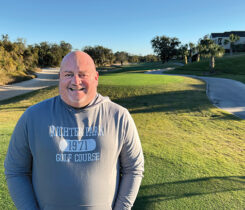No magic bullet for managing ABG putting greens

Mike Kenna
Annual bluegrass (ABG) or Poa annua, affects almost all golf courses. Do you live with it or try to eradicate it? For years, living and working in the bermudagrass belt, I was in the eradicate group. Yet, I have played golf on Northeast and Pacific Coast courses that have excellent ABG greens.
C. V. Piper, Ph.D., and R. A. Oakley, Ph.D., concluded in their March 1921 Bulletin of the USGA Green Section:
“On the whole, the grass is to be considered desirable rather than a weed. Certainly, it would be very expensive to keep it out of greens altogether, and surely its demerits, if any, are not sufficient to justify the attempt.”
These are very prophetic words for where we are nearly 100 years later. Yet, for courses in the Transition Zone and upper south, summers with ABG are unsettling. Creeping bentgrass is challenging enough without trying to keep the ABG healthy. Northern courses worry about winterkill. And then there are anthracnose and annual bluegrass weevil problems to combat.
The USGA supports research on breeding, managing and controlling ABG. The Green Section funded ABG breeding programs in the 1980s through the early 2000s. In 1998, Don White, Ph.D., at the University of Minnesota, released “DW-184” or “True Putt,” a perennial putting green biotype. He even suggested a name change to creeping bluegrass (Poa annua var. reptans to Poa reptans).
In 1994 at Penn State University, David Huff, Ph.D., started an ABG breeding program. He collected perennial types from top-name courses with the help of the Green Section. This breeding effort looked promising until it came time to produce seed. The attempt failed because selected seed from ABG putting green types looked nothing like the parents.
Golf course superintendents have benefited from research on the management of the natural ABG biotypes. In 1980, Patricia Vittum, Cornell University, completed her Ph.D. dissertation on the biology of the annual bluegrass weevil (ABW). Albrecht Kopenhoffer, Ph.D., at Rutgers University also has provided annual bluegrass weevil management strategies. Ben McGraw, Ph.D., continues to add to the ABW research effort (see last month’s issue). These entomologists, along with Steven Alm, Ph.D., University of Rhode Island, and Richard Cowles, Ph.D., University of Connecticut, are tackling ABW insecticide resistance problems.
Excellent research on anthracnose management at Rutgers University by Bruce Clarke, Ph.D., and Jim Murphy, Ph.D., busted several management myths. Contrary to what many thought, light sand topdressing and nitrogen fertilization were beneficial for managing the disease. Their work helped reduce the number of annual fungicide applications to manage
the disease.
Yet, there is always the question of controlling ABG in favor of creeping bentgrass. The article in this issue led by Aaron Patton, Ph.D., Purdue University, examines a longer-term systems approach. Some of the treatments reduced ABG, but none provided complete control. The recent availability of PoaCure (methiozolin) is promising and will help reduce ABG in putting greens. My concern is the potential ABG herbicide resistance to the repeated use of products with similar mechanisms of action.
Annual bluegrass herbicide resistance has become a big problem and has received national attention. A $5.7 million USDA grant to a team of 16 scientists across 15 universities is underway. Led by Muthu Bagavathiannan, Ph.D., Texas A&M University, the team will characterize ABG herbicide-resistant populations. They will look for weaknesses in ABG seed biology and growth characteristics. Also, they will develop alternatives to herbicides to supplement current control measures.
I have accepted that annual bluegrass is going to be around for several years. There is no magic bullet whether you are managing ABG putting greens or trying to keep it from invading your bentgrass greens. The good news, though, is that there’s more research today to deal with annual bluegrass management and control.












